by DAVID ROLINSON
Screen Two; Writer: AFN Clarke; Director: Alan Clarke; Producer: Terry Coles
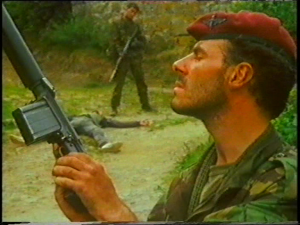
The first production to be shown in the Screen Two strand, Contact was broadcast on BBC2 at 10.10pm on Sunday 6 January 1985.1 An account of British Army patrols around the border in South Armagh, Contact was an appropriate start for Screen Two given its contemporary concerns, politically sensitive subject matter and distinctive style. Filmed between 6 and 29 August 1984, Contact was directed by Alan Clarke.2 It is one of the highlights of Clarke’s astonishing body of work. Jim Naughton’s review of Contact is largely characteristic of the critical acclaim that it received: “a crisp, tight, elegant piece of work, wonderfully shot […] by Philip Bonham Carter and making brilliant use of sound”, the film “found a new angle on Northern Ireland, which is more than can be said for most programmes about that […] province”.3 Typically for a Clarke piece it achieved more acclaim abroad, winning the Golden Leopard’s Eye at the Locarno International Film Festival, where the jury praised the “intelligence and precision with which the camera describes the story of a British patrol in Northern Ireland while leaving the spectator free to judge”.4 Clarke described the win as a “high spot” of his career, “absolutely great”.5 However, there was another Clarke at work on Contact whose own contribution has been underexplored: its writer, AFN Clarke…
Contrary to the claims of some critics, AFN Clarke is not Alan Clarke,6 nor is he a relation – he is Anthony (Tony) Clarke, though I will continue to use ‘AFN’ in this article for consistency. He is not one of the many collaborators interviewed for Richard Kelly’s Alan Clarke, and his contribution is underexplored in my own book Alan Clarke. Instead, I placed Contact alongside Psy-Warriors and Elephant, pieces by different writers, to talk about discourses relating to terrorism within my overall concern with this director‘s body of work and the thesis’s theoretical concepts such as ideology. So, reasons of structure, argument and space were mostly responsible for my lack of coverage of the relationship between Alan Clarke’s Contact and its source book, AFN Clarke’s Contact. This omission risks skewing the critical discussion, at least until Contact gets the number and depth of studies that this great television drama deserves. Therefore, this article returns to Contact, reproducing much of my book’s analysis but also revising it with new material including, most importantly, reference to the source book, which I’ve incorporated when teaching the film on my University of Stirling module Terrorism in the Media since 2010. This article makes no claim to being definitive – indeed, I hope to return to Contact later as part of a wider research project on terrorism in British television drama – and there is much left for further scholars to say.

The book Contact is AFN Clarke’s first-person memoir of tours in Northern Ireland with the Parachute Regiment: half of the book details his time in Belfast (not covered in the film version), while the second half details his border patrols near Crossmaglen in South Armagh.7 In an initially close collaboration – detailed in Richard Kelly’s interview collection Alan Clarke – AFN Clarke developed a detailed and semi-autobiographical script around the breakdown of a Platoon Commander.8 As was typical of much of the director’s work in the 1980s, the script was pared down. Lead actor Sean Chapman told Kelly that “Alan was respectful of writers and writing. He wasn’t one for letting actors change whatever line they liked […] There was no ‘make it up as you go’ feel, ever. But the time I saw him remake a script was Contact“, with the removal of plot exposition and much dialogue, until Contact became a “set of sequences, describing army operations”.9 In the final programme, there is often a refusal to provide motivational detail, and I’ve analysed the effects of that refusal in my book and will do so again in this article. In a problematically auteurist maneouvre (albeit one tied to a theoretical reading of ideology), I’ve tried to interpret this refusal of context by looking at the director’s earlier Psy-Warriors and later Elephant.10 Taking their lead, I read Contact’s treatment of these operations in terms of the discourses of British rule, colonialism and ideology.
However, interpreting the film in this way should not involve neglecting AFN Clarke’s contribution – although Clarke’s paring-down of scripts caused problems in later dramas, Contact remained a collaboration. Corin Campbell Hill, Contact‘s production manager, told Richard Kelly that AFN Clarke “was on the set pretty much throughout”.11 Indeed, the collaboration went deeper than this, as AFN Clarke has explained: ‘In fact I was not only onset all the time, I also chose all the locations, trained the actors and myself and stunt coordinator Terry Forrestal blocked all the scenes with the actors over five days, with none of the production team present including Alan Clarke. I also was present throughout the entire editing process and working alone with the sound editor dubbing the correct sound effects related to the weapons being used.”12 But my focus will be on the impact of the original book. For instance, the repetition of scenes (in particular walking scenes) might well resemble numerous other Alan Clarke films – Made in Britain, Christine and Elephant in particular – or be productively compared with the discussion of circularity in Psy-Warriors, but it is also a feature of AFN Clarke’s book: “The hours drag on and eventually the rota becomes the only way of knowing which day it is. Day succeeds night succeeds day in a monotonous cycle enriched with the cold wind and the rain”.13 The refusal of motivational detail in the film is also the result of Alan Clarke developing a style which emulates in film terms the numbing routines that are described in the book. Having said that, the book does provide much more factual and emotional information than the film, and so thinking about what has been lost does give us a way into the film’s strategies. The book is told from a first-person point-of-view rather than from the outside, and the military perspective makes it an essential reference point on my terrorism module, which features a number of competing terror, counter-terror and academic perspectives. The book is also vital because it provides a clearer sense of motivation which the film often (though not always) omits, and a view of the conflict that sits distinctively within the module’s numerous representations from broadcast fiction and non-fiction, journalism and other sources. Examples of the information and opinion that the book provides but which the film does not make explicit: the statement that distrust or hatred towards the British Army occurs within the Loyalist community and groups as well as the Nationalist community and groups; we are told why the soldiers need to travel by helicopter, how the bases run; what the threats usually are; where those threats come from; and (as we shall see) why the soldiers do certain things.
The significance of the location is stressed less by the film than by the book and various studies. AFN Clarke’s book describes the base at Crossmaglen as a “tactical farce […] in a pocket of the North surrounded on three sides by the border with the Republic, and the entire population of the district, with the exception of a couple of Prots, are Catholic, anti-British, pro-I.R.A. and a law unto themselves. Bandit country, the media have called it and it’s not a bad label.”14 As Toby Harnden discusses in his history of the IRA in South Armagh, the description “Bandit Country” was applied in 1975 by Merlyn Rees, then-Northern Ireland Secretary, because of how ‘dangerous’ it was for British soldiers, and so it remained.15 (Harnden notes that a senior Army officer “added that the term ‘Bandit Country’ had been entirely counter-productive for it had fuelled the South Armagh Brigade’s sense of inevitability and planted fear in every soldier’s mind”.16 ) Crossmaglen in particular “is a place of hostility, isolation and the constant threat of death. Before going out on patrol, troops are briefed that every gorse bush, stone wall or ditch, every cowshed, milk churn or bale of hay could hide a bomb; if a sniper decided to strike, the victim would probably never even hear the crack of the bullet being fired.”17 These are among the sensations evoked by the film.
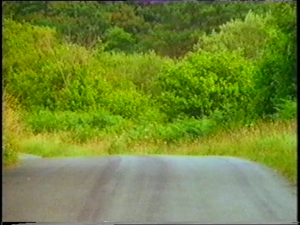
In my book, after providing a history of censored or banned programmes on Northern Ireland and analysing Psy-Warriors, my analysis of Contact begins with the opening scene. Contact opens with an establishing shot – held for a fair few seconds – of a country road. The road’s framing in the foreground acts to mediate the lush greens of rural Ireland in the background,18 a shot which demonstrates an incursion by urban space. What I didn’t add was that the source book also uses intrusion imagery – for instance, ‘the base looking like an obscene sculpture on the green landscape’.19
Eventually, a car speeds into view. Several British soldiers emerge from outside the frame and block the road. This opening image establishes a contrast between the natural green of the countryside, a pure green with connotations of Ireland and Irish nationalism, and the camouflage uniforms of the soldiers, here first seen against the grey of the road. There’s a similar contrast between their uniforms and the organic greens and browns worn by locals they interrogate. These shots reinforce the idea that the soldiers cannot assimilate themselves fully into their surroundings. I’m still content with this observation of mise-en-scène, in that the clash of organic and non-organic colours and textures is a clear visual thread throughout the film. However, I do think that I leap too quickly into interpreting that, in a baldly-stated way, before I’ve provided enough evidence. If the locals seem innocent, then that’s perhaps an ambiguity left by the film: the source book gives us a more detailed sense of the possibility of threat, the tactics that groups use and why soldiers might be particularly on edge at given moments. Toby Harnden details the use of ‘scout cars’ to check that roads are clear of soldiers. However, as the scene develops, our first view of ‘contact’ between the soldiers and the Irish is based upon the British exercising their power. One man is shot dead, the other lies on the ground while the unspeaking Commander pushes a gun into his face. Throughout this scene, and for most of Contact, the Irish are silent. Described simply as “gun-runners”, they represent an administrative problem for British rule, which is deaf to, or actively silences, the subaltern culture of the indigenous people. This kind of colonial reading is reinforced by the description of Northern Ireland in Psy-Warriors as Britain’s “last colonial battlefield[…] the rear end of the cruelty and exploitation of over thirty colonial wars”. The Interrogator, using an image which we might see as anticipating the circularity of Elephant, compares the situation to “a dog devouring its own tail”.
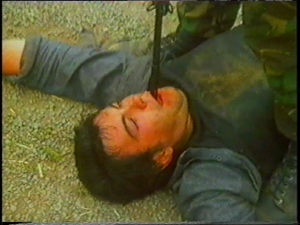
If we’re to read this scene from Contact in ideological terms, it’s partly because of its virtual replication later, when the soldiers shoot gun-runners and the Commander forces his gun into the mouth of a captive.20 Reflecting the Interrogator’s “symbiotic” rhetoric, the guns are being transported to locals to fight the British soldiers, so the repetitious skirmishes continue because the soldiers remain present; their first appearance blocks both the frame and the road, obstructing the movement of the Irish and our view of them. Drama stems from the soldiers’ misreading of signs. In a way that comes from the book, which tells us: “The closer we get the more alert we get, stopping at the slightest sound, listening for long minutes, eyes trying to pierce the darkness and interpret the shapes. Buildings take on a sinister presence […]”.21
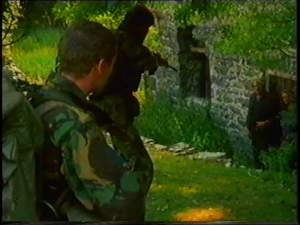
As in the source book, they find danger in gun magazines left on the grass and a couple emerging from a derelict building (who in the book are more clearly described as being extremely poor and dirty). The crisis point is always, as the title implies, at the point of contact between the soldiers and the Irish. Toby Harnden also discusses soldiers’ difficulties in reading signs. He quotes Jim McAllister’s argument that “If they come here for six months at a time, they are never going to really learn the area like people who were born and reared here. They might be watching everything and see Farmer Joe go by with his tractor loaded with hay three days of the week but one day it’s not Farmer Joe but IRA man Joe and he’s got something extra underneath his hay. They don’t know that and that’s why they’ll never win this territory. It’s to do with community, it’s to do with history”.22 As in Psy-Warriors, elements of Clarke’s style reflect the limited view of the soldiers, in the process exposing the power inscribed in the act of looking, a Foucauldian theme that I develop in different parts of the book. Largely, Clarke uses a hand-held camera to react to events with an “unmediated” rhetoric reminiscent of documentary. In the 1980s, Clarke often used Steadicam to walk “with” characters, but this is not the signature device of Contact. The effect is to link the observational camera with the distanced state. In the soldiers’ operations in what they describe as “bandit country”, the Irish are the unelaborated “Other”, a mostly unseen presence of which we only become aware when British soldiers come under attack. At those points the camera reacts, lurching and zooming in a vain search for the gunmen. That is also an impressive feature of Full Metal Jacket (1987), whose director Stanley Kubrick apparently saw and admired Contact.23
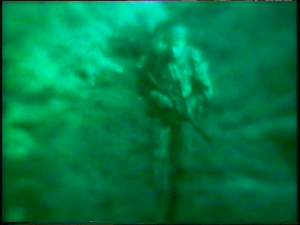
In addition to the two shades of green mentioned earlier, in the night sequences Clarke gains a night-vision effect. In the book I lazily call this “infra-red” (confusing the process with the effect), admittedly reinforced by Tim Roth when he described the call he received from Alan Clarke to play the lead in Contact: “I’ve got this great part for you, it’s all night shoots; we’re gonna do infra-red night vision, handheld camera”.24 Actually, the view was achieved by adapting military sights, as AFN Clarke recalls (in a discussion of his contribution to the collaboration): “It was also my idea to use the Image Intensifying sight and I worked with Phillip Bonham-Carter to get the right equipment and carry out the camera tests.”25 Brian McIlroy noted from these shots that we are seeing “a society predicated upon clandestine surveillance”.26 Furthermore, the night camera has the disorienting effect of filling the screen with overwhelming greens. Again, we can note that this reflects the source book: “Looking at the ghostly greeny countryside through the image-intensifying sight gives me the feeling of unreality”.27 Nancy Banks-Smith observed that the platoon is ‘bathed in a thin, liquid green light like aliens’.28 The title Contact reinforces this notion of the platoon trespassing in an alien landscape. Furthermore, as Howard Schuman proposed, it could turn “us into alien observers; the viewer is therefore both comrade and enemy, victim and aggressor”.29
As he often did, Clarke resists the editorialising use of music and non-diegetic sound, leaving only distant bird call or the rustling of trees. According to Banks-Smith, because of the way in which the soldiers “prowled in… such silence”, the viewer’s ears “grow points and prick forward with the aching acuteness of the hunter and the hunted”.30 The rural soundtrack is displaced when we move to scenes in Army quarters underscored by the unnatural humming of a power source. The sounds of the countryside are replicated by artificial echoes, like the showers which clean the soldiers after wading through rivers, or blocked out altogether by the personal stereos with which the young troops relax on their bunks. The base, therefore, becomes a limbo in which the British are further distanced from their surroundings. This is reflected in the camera’s own distance from the Commander, which makes it appear, as Jim Hiley observed, “as if the camera approaches him with extreme wariness”,31 and in army psychology, as the Corporal tells the Commander, “Don’t get involved, boss. It’s bad for the brain”. Again, I could have related this to an equivalent scene in the source book: “I don’t want to know you, because to me you will be just another number when I shovel what’s left of it into a body bag”, translated as “I don’t want to get involved because I don’t want to get hurt.”32 The close-ups were shot on long lenses, to the extent that Chapman was often unaware that he was in close-up,33 with the effect of making Ireland a hazy and indistinct background, as Clarke according to Richard Kelly “framed these soldiers as figures in a landscape where they have no mission, no prayer and no place”34. Contact, therefore, becomes a post-colonial war film, in which Clarke’s strategies both demonstrate the landscape’s refusal to be easily defined and locate the act of looking within the discursive frameworks of colonialism.
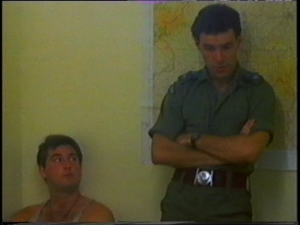
This is reflected in its minimalist narrative. Although the film contains a small number of understated briefing scenes at which tactics (and, to answer my earlier point, locations) are discussed, there is overall no clear statement for us of defined mission aims or understanding on the part of the British – there is instead a number of repetitive searches and seemingly pointless deaths. Up to a point, Contact is operating within the modes of the “tour of duty” war film, but, contrary to our expectations of that genre, and potentially contrary to the source book, we are not led to empathise with the soldiers. Through its sparse characterisation, Contact, according to David Leland, “breaks the mould of the soldiers-at-war film. There’s no chirpy Cockney or dour Scot and nobody takes the piss out of a character called Taff”.35 This is generally true, although the last point is slightly undercut by one soldier’s speculation on another soldier’s night life after hearing the sound of off-screen sheep. Contrary to the iconography of the war film, there is no narrative causality or resolution. As a non-discursive war film focusing on the problems of leadership, Contact has some correlations with the films of Samuel Fuller, who according to Phil Hardy often “excludes as much as possible in the way of context and films the internal pressures” on an unsympathetic leader and the men he leads, who do not know why they are fighting.36 The Steel Helmet (1951) follows a patrol behind enemy lines, whose protagonists are deceived and confused by the native land, and “enter a limbo of their own. In a slow pan across their faces, Fuller shows them staring blankly ahead” as madness is “the only form of impassivity… available to men at war”.37 Fuller also made use of a walking motif. As another leader says in Merrill’s Marauders (1962), “When you come to the end of your rope, all you have to do is put one foot in front of the other, just take the next step – that’s all there is to it.” To place Contact in the context of the British war film, Robert Murphy, commenting on the way in which The Long and the Short and the Tall (1961) was celebrated for “its boldness in concentrating on a unit of squabbling, foul-mouthed and distinctly unheroic soldiers”, argued that “The film it most resembles is Alan Clarke’s Contact’.38 David Thomson compared Contact with Anthony Mann’s “abstract study of an infantry patrol lost in Korea”, Men in War (1957). Mann “has never had an equal at the depiction of landscape, immensely extended spatial relationships, and the dramatics of distance”. Though “Clarke’s style is not as classical as Mann’s”, Contact’s strategies also employ physical movement to convey “the animal in people… dwarfed by eternity and the tranquility of the land”.39 Clarke’s avoidance of conventional narrative strategies made Contact, in Amy Taubin’s phrase, “a rare thing – a truly antiwar movie”.40 According to V. F. Perkins, the effect of such conventional strategies on David Lean’s The Bridge on the River Kwai (1957) was to undermine its proclamation of “the futility of war”, with “emotional dynamics” which “invited us to share in the excitements, tensions and triumphs offered by the action”. Therefore, in Lean’s film, “War was said to be futile and experienced as glorious, victory was said to be empty and felt magnificent”.41 This is in stark contrast to Contact‘s qualities as described by Dennis Hackett, as “Clarke’s taut, atmospheric direction… brought the sick tension of it all through strongly”. Actor Sean Chapman observed in comparable terms: “It seems more and more pointless, the more vehicle checks you do, the more silly gunfights in a field, where nobody seems to win anything. In that sense it’s an anti-war film without ever talking about the pointlessness of its project, it’s interwoven in the shot choices and so on.”42 Hackett added of the pared-down script that “It is unlikely that any play this year will have fewer words” but “A more fulsome script would… have been inappropriate”.43
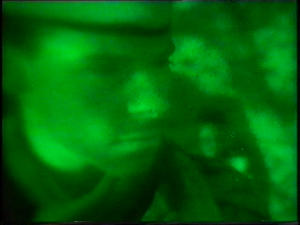
Contact’s soldiers resemble Scum’s trainees, which I’d be tempted to see as a deliberate paralleling of institutionalised youth, given that Scum was intended as part of a trilogy including a play about youths entering the army. In the regimented, imprisoning headquarters, the young men, led by Scum’s “daddy” John Blundell, eat and wash communally before retiring to their cell-like rooms.44 The soldiers’ youthful vulnerability is emphasised by a scene in which they discover a group of children out camping. The Commander seems troubled by one child staring up in fear at the platoon, a reflection of the mysterious armed confrontations suffered by his own young charges, and a foreshadowing of his own guilt. Again, these are ideas described in the source book: “It’s a bit like playing hide and seek […] Grown-ups playing children’s games with death the only winner.”45
In such sequences we see, as Brian McIlroy observed, the “tension” implicit in the position of the soldier who “follows orders and tries not to get killed in the process”, as Clarke depicts routine “with his almost mathematical precision”.46 But if we turn to the source book to think about what the soldiers are thinking and feeling, we find opinions that make my book’s ideological analysis of what the film is doing seem a little too neat at times. For instance, the film contains no direct equivalent of this observation from the source book:
We must be the only Army in the world that has to account for every minute of time, every action taken. Guilty until proven innocent, my Lord. Yellow cards with instructions on when to open fire. White cards on arrest procedures. Another white card on the use of P.V.C. baton rounds, and yet another on how M. 79 grenade launchers can be used. Will you please stop the battle, I have to consult my yellow and white cards.47
In their 1983 book Televising Terrorism, Philip Schlesinger, Graham Murdock and Philip Elliott discuss the film Who Dares Wins (1982) and its associated novel The Tiptoe Boys in terms of tensions in the official perspective between maintaining order and maintaining the rule of law, finding in The Tiptoe Boys “reactionary populist sentiments” regarding serving in Northern Ireland:
…those cringing wankers at Westminster put me and my mates in there to clean up their shit. But are we allowed to fight as soldiers are trained to fight? Christ, no. We’ve got to ride round like fucking human targets and be shot at first. Then we’re allowed to shoot back if we’re still alive, but we mustn’t use too many rounds and there’s fucking hell to pay if we do. You reckon the Provos do that? Do they hell. They’re laughing at us…48
Using the Televising Terrorism methodology, we might wonder whether the above quotations make both Contact and Who Dares Wins examples of the official perspective, with Who Dares Wins moving most clearly into the harder-line populist category. However, Contact is a very different film from Who Dares Wins, and in the context of my reading of the film within Alan Clarke’s Northern Ireland pieces as a whole, the finished version might be placed within the terms of the alternative perspective (perhaps even the oppositional, if we take some of the discussions in Psy-Warriors as a cue to read its depiction of silence, absence and circularity). I won’t go into those perspective distinctions too much here because these are questions for students of terrorism in the media to tackle.
However, the two quotations above do valuably complicate attempts to categorise either version of Contact. The film mostly loses the kind of overt expression of soldiers’ thoughts and feelings that we see above, but that doesn’t necessarily mean that they are excluded – and I’ve often worried about whether to take at face value the director’s statement to Chapman that “I’m not fuckin’ interested in the army, it’s full of idiots”.49
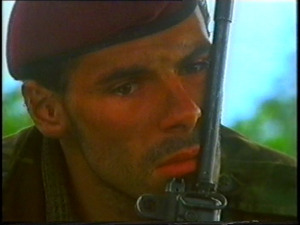
Although Contact resists overt signposting, it often captures Chapman’s character in what Richard Kelly calls “quite terrifying moments of mental absence” which demonstrate an analysis of “illegitimate authority”.50 Jim Hiley wrote that “Contact is completely engrossing – not because we identify with the soldiers, but because of what we learn about them. Even their excesses show a sort of logic… the logic of an intolerable situation”. Amy Taubin noted that “Watching, we identify not with specific individuals nor with one side or another, but with the terror and absurdity of being there”.51 In the source book, AFN Clarke sees his own “lost expression” as a “pallid spectre”.52 What are we left with? According to Brian McIlroy, the film “poses a series of veiled questions which Clarke’s unremitting observational style of fictional filmmaking avoids answering directly – Who are they fighting against? Why are they there? What do they think about their job?”53 Once we get into wider questions, we are into areas of interpretation that might sound more provocative than they do in my book, where Contact is placed in the context of a body of work and a clearly-stated methodology, not that this means viewers and other critics can’t disagree with me. Instead I’ll quote Howard Schuman, who thinks that we are left with the “unstated question – why are the English in Ireland?… to which there is no clear answer, only a lament for wasted lives”.54 The source book may or may not share that interpretation, but the phrasing of Schuman’s point is surprisingly similar to the last two lines of the following statement:
Dead at eighteen. Not an accident or natural catastrophe, but publicly murdered, snuffed out before he has the chance to even know what all this is about, before he has known what life is. That makes two now, because the other guy who was blown up, in Sgt. Donne’s patrol, died after a week. What did they die for? The recurring question that defies answer.55
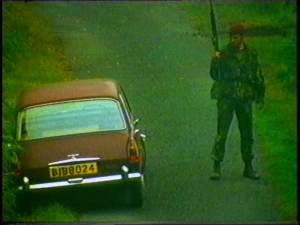
Recurring questions that defy answers are important throughout these two versions of Contact. Clarke refuses to flesh out the Commander’s character, to the extent that his actions toward the end of the film seem baffling.56 The source book does give us a sense of a surface performance at work, even at times when they are operating in areas in which they are usually fired upon: “Outwardly I’m calm and unconcerned, as I casually negotiate a ditch and scramble up the other side. Inside I’m coming apart at the seams, fighting the rising fear and the temptation to find a hole and crawl into it. […] Just to lend a bit of authenticity to my play-acting, I stroll slowly across the road, in full view of any potential sniper positions.”57
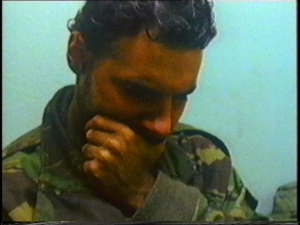
The film’s refusal to flesh out the Commander’s character supports its rhetoric of absence, and his breakdown, though never made entirely explicit, forms an existential distanciation that we can map onto some of the earlier critical points about the wider situation being depicted. Contact ends with the Commander looking broken (or, to follow my earlier point, without an answer), in a mid-shot against a brick wall. This shot is a variation on the ending of Made in Britain, connecting the two. Indeed, Tim Roth was at one stage signed up to play the lead.58 Clarke’s subsequent move from the rural spaces of Contact to the urban spaces of Elephant partly supports the observation by Michael Walsh that films tend to feature a “polarisation of images of Ulster” of “city centre versus country, especially border country”. On one level, Clarke operates in the “same binary”, because the countryside of Contact, whether a wilderness imbued with ‘Otherness’ or a historical Ireland resisting its colonisers, contrasts with the urban space as controlled area of production captured in the machine-like structure of Elephant.59 This rural/urban binary – which could have been explored within Contact had the whole source book been attempted – soon seems to collapse, because Elephant seems to make clear that these spaces are ontological rather than geographical, not so much Irish views as views of Ireland.
There are still issues with my analysis here. The resistance of direct comment in Contact might also be related to Clarke’s respectful awareness of his own status as an outsider. While defending Elephant on Open Air in 1989, Clarke said that he and its producer (Clarke and Danny Boyle co-devised its concept) had been wary of the original project because they risked being “a couple of Englishmen visiting Ireland, doing a kind of pseudo-important drama and getting out of there”.60 He often made comments like this. In relation to Rita, Sue and Bob Too (1987), he said that “What I can’t stand is the kind of film-maker who scoots up North, shoots a film about how depressed things are as quickly as possible and encourages ‘the natives’ with banalities like ‘Great! I like it! Keep things bad! Make them worse! I’ll be back next year!'”61 Reading Contact‘s spaces as ontological does depend on a completely different text (Elephant), devised under different circumstances. Also, as we’ve seen, there’s a lot more work to be done regarding Contact, in particular as an adaptation of a fascinating and quite different source book.
Its appearance at the very beginning of the Screen Two strand makes it even more significant. Writing in The Listener a few weeks after Contact was broadcast, Mike Campbell noted that “the traditional studio ‘play'” was being replaced by Film on Four and “its BBC2 rival Screen Two“.62 Elsewhere in my book I talk about the institutional noises in defence of the television studio as a space for radical, distinctive work – Clarke’s Psy-Warriors is held up by the BBC as an example – so I mention Campbell’s piece not to unproblematically accept the narrative of cinema replacing studio drama in the 1980s but to note his observation that “the semantics” of words like play and film “didn’t matter much” in the days of Cathy Come Home which “clearly belonged neither to the cinema nor to the theatre” but the rise of Screen Two and Screen One (even their names) meant “new definitions seem to be called for”.63 Given that I’ve used the word “film” throughout this essay, this is a point I have to make room for. Films made for television were “a distinctive art-form in their own right”, but that television was increasingly “reluctant to accept that it can be an autonomous medium, influenced by but not dependent upon others”.64 These are issues for another day, but I raise them because of Campbell’s choice of examples: “The two outstanding contributions so far – Alan Clarke’s Contact and Mike Leigh’s Four Days in July – significantly both drew on television’s strengths in order to extend its range.”65 At a time when “television’s new commitment to film is essentially a hybrid form” – a “compromise” between cinema and television – works like Contact and David Pirie’s Rainy Day Women suggested to Campbell that cinema, as well as television, could benefit from television remembering its “televisuality”.66
Thanks to AFN Clarke.
Contact was released on DVD and blu-ray by the BFI in 2016, both within their excellent Alan Clarke collection and, on blu-ray, on its own.
Originally posted: 30 November 2012
[This piece first appeared as a small section of my book Alan Clarke in 2005 (which was republished unchanged in paperback in 2011). It is presented here with substantial revisions, including a lot of new material.]
Updates:
3 December 2012: Minor corrections and the addition of extra quotations from Chapman, Campbell Hill and Roth.
4 December 2012: Minor additions including Campbell quotations.
5 July 2013: Addition of comments from AFN Clarke, and consequent amendments to surrounding text, including bringing some material from endnotes into the main body of text.
25 August 2014: Clarified prize won at Locarno and added jury quotation.
31 October 2015: Minor correction: removed two duplicated sentences.
5 February 2017: Added link to BFI releases.

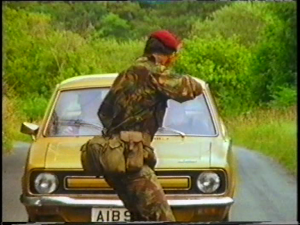
I wish the BBC would either release “Contact” on DVD or Give it another very overdue Airing.
It is one of the best British Films ever made in my View…
As the author of CONTACT the book and screenwriter and collaborator of CONTACT the film, I do commend this great article by David Rolinson. He had the grace to reply to a comment I made about chapter 3 in his book about Alan Clarke and listened to what I had to say on the subject of CONTACT the film. For all those who seem to think otherwise, Alan Clarke did not write the screenplay, nor did he train the actors or block the scenes with the actors. Nor did he choose the film’s location, he asked the stunt coordinator and myself to take on those tasks. I also applaud David for recognising that few journalist or critics have ever bothered to interview me about CONTACT which is essentially about me based on my book. Perhaps I should write the true story of the making of CONTACT the film, from the beginning when an independent TV producer, Nicholas Claxton, who brought my book to Alan Clarke’s attention, arranged for Goldcrest to pick up the film rights. When Goldcrest then reneged on the deal it was bought by the BBC and Nicholas was subsequently sidelined by the BBC for their own insipid and ineffective producer. That is just one of the stories.
Pingback: Alan Clarke: Play for Today biography | British Television Drama